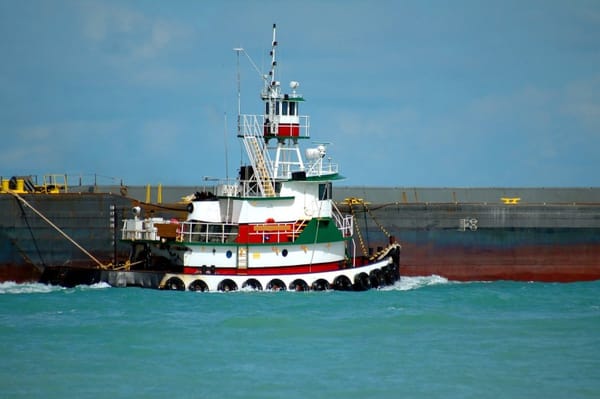<i>Shell Offshore v. Tesla Offshore</i>: Questions of Towing
Michael Orlando | November 2, 2018

The Fifth Circuit Court of Appeals recently decided a maritime case, Shell Offshore, Inc. v. Tesla Offshore, LLC, 2018 U.S. App. LEXIS 28298 (5th Cir. 2018). It falls into the category of one that would have been difficult to predict based on the law, taken in the context of offshore supply vessels (as opposed to brown water vessels like tugs). But, perhaps not, based on the facts in the context of towage in general.
The M/V International Thunder was pulling a 14,000-foot cable connected to a sonar device (known as a towfish) to survey the ocean floor when it allided with a mooring line of Shell's mobile offshore drilling unit, Deepwater Nautilus. Shell sued the owner of the Thunder, International Offshore Services, and the owner of the surveying equipment, Tesla Offshore, which chartered the vessel and directed it where to survey on a grid.
Earlier in the year, Tesla had received info on the mooring line layout of the drilling rig but thought it was no longer applicable as the surveying was later in the year. On the day in question, no one contacted the drilling rig, and the towfish hit a mooring line, causing a delay in drilling. A jury awarded Shell over $9 million, with Tesla found to be 75 percent at fault and International found to be 25 percent at fault.
What Constitutes a Towing Vessel?
What makes this case of interest is that International challenged the district court's ruling that the Thunder was a "towing vessel" under 46 U.S.C. § 2101, which requires the captain to hold a towing license he did not have. Arguably, International was denied limitation of liability because of that.
On appeal, the Fifth Circuit invited the views of the US solicitor general "on whether applicable laws and regulations at the time of the allision required the master of the Thunder to have a towing license. The government filed an amicus brief supporting the district court's legal conclusion that the Thunder was a towing vessel whose captain was required to hold a towing license."
The US Code defines a "towing vessel" as "a commercial vessel engaged in or intending to engage in the service of pulling, pushing, or hauling alongside, or any combination of pulling, pushing, or hauling alongside" under 46 U.S.C. § 2101(50). International made various arguments as to why the Thunder should not be considered a towing vessel, but the court kept coming back to the view that one must look to the service the vessel was providing to properly interpret the statutory definition.
Here, the vessel was pulling sonar survey equipment, so it did not matter that this was not traditional towing activities such as one vessel helping another vessel make a voyage. The service provided by the vessel fit the statutory definition.
"This definition expressly contemplates that a towing vessel may tow objects other than vessels.… As the government notes in its brief, accepting the definition proposed by International would permit the transportation of large and potentially dangerous objects without a towing license."
Further, the court said:
Nor do we accept International's alternative position that towing involves assisting the voyage of a vessel or object from one point to another rather than pulling equipment around a work area. The statute does not limit where or when the "pushing, pulling, or hauling along side" can occur. And whether the towfish was placed in the water at port or at sea has no apparent bearing on what regulations should apply. Finally, it is not determinative that the THUNDER was documented as an offshore supply vessel rather than a towing vessel. A vessel can fall into more than one statutory category. See 46 U.S.C. § 3302(a)(1). Accordingly, the district court did not err in instructing the jury that the THUNDER was a towing vessel and that its captain lacked a towing credential.
One of the more interesting things to note is that there was evidence presented at trial that existing towing regulations and licensing training programs do not address the towing of submerged objects like the towfish. Thus, even though the court holds this vessel under theses circumstances as a "towing vessel" and, therefore, its captain had to have a towing certification, the regulations and licensing training programs would not have trained the captain for that function. So, who would have thought in advance that the captain needed such a certification?
Conclusion
In the author's view, the case may well have had a different outcome if the US solicitor general had not sided with Shell that the captain was required to have a towing certification—for which the regulations were silent on the towing of sonar equipment and for which there are no licensing training programs.
Under the facts, though, it is hard to say pulling sonar equipment in open water on a 14,000-foot cable does not fit within the law that a towing vessel is a commercial vessel engaged in or intending to engage in the service of pulling, pushing, or hauling alongside, or any combination of pulling, pushing, or hauling alongside. The lesson to be learned is do not wear blinders when traditional maritime activities are part of the equation. Most people probably would consider this, in the abstract, as "towing."
These are the author's personal views and not those of the firm or its clients.
Opinions expressed in Expert Commentary articles are those of the author and are not necessarily held by the author's employer or IRMI. Expert Commentary articles and other IRMI Online content do not purport to provide legal, accounting, or other professional advice or opinion. If such advice is needed, consult with your attorney, accountant, or other qualified adviser.

